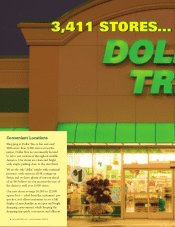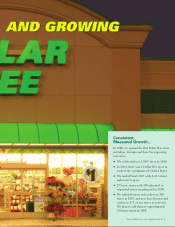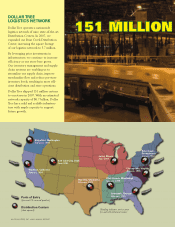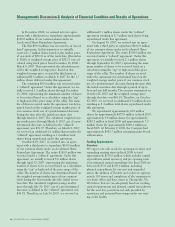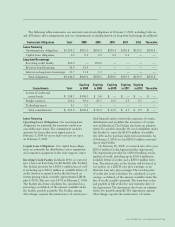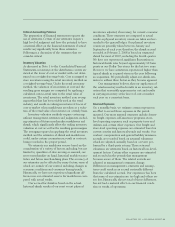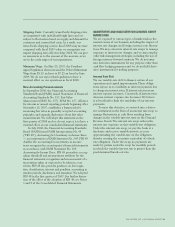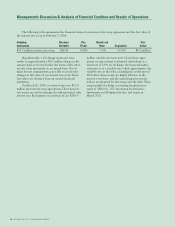Dollar Tree 2007 Annual Report Download - page 18
Download and view the complete annual report
Please find page 18 of the 2007 Dollar Tree annual report below. You can navigate through the pages in the report by either clicking on the pages listed below, or by using the keyword search tool below to find specific information within the annual report.
16
DOLLAR TREE, INC. • 2007 ANNUAL REPORT
Management’s Discussion & Analysis of Financial Condition and Results of Operations
Fiscal 2006 ended on February 3, 2007 and
included 53 weeks, commensurate with the retail cal-
endar. The 53rd week in 2006 added approximately
$70 million in sales. Fiscal 2007 and 2005 ended on
February 2, 2008 and January 28, 2006, respectively,
and both years included 52 weeks.
In fiscal 2007, comparable store net sales
increased by 2.7%. This increase was based on the
comparable 52 weeks for both years. We believe com-
parable store net sales were positively affected by a
number of our initiatives over the past year, including
expansion of forms of payment accepted by our stores
and the roll-out of freezers and coolers to more of our
stores. During 2006, we completed the roll-out of pin-
capture debit card acceptance to all of our stores,
which has enabled us to accept Electronic Benefit
Transfer cards and we now accept food stamps in
approximately 1,100 qualified stores. We believe the
expansion of forms of payment accepted by our stores
has helped increase the average transaction size in our
stores. On October 31, 2007, all of our stores began
accepting VISA credit as well, which we expect to
have a positive impact on future sales.
We continued to experience a slight shift in the
mix of merchandise sold to more consumables which
we believe increases the traffic in our stores; however,
this merchandise has lower margins. The negative
impact from the planned shift toward more consum-
ables was smaller in 2007 than in 2006. The planned
shift in mix to more consumables is partially the result
of the roll-out of frozen and refrigerated merchandise
to more stores in 2007 and 2006. At February 2, 2008
we had frozen and refrigerated merchandise in
approximately 1,100 stores compared to approxi-
mately 700 stores at February 3, 2007. We believe that
this will continue to enable us to increase sales and
earnings by increasing the number of shopping trips
made by our customers and increasing the average
transaction size.
Our point-of-sale technology provides us with
valuable sales and inventory information to assist our
buyers and improve our merchandise allocation to our
stores. We believe that this has enabled us to better
manage our inventory flow resulting in more efficient
distribution and store operations and increased inven-
tory turnover for each of the last two years. Inventory
turnover improved by approximately 25 basis points
in 2007 compared to 2006 and by approximately 45
basis points in 2006 compared to 2005. Inventory per
store has also remained constant at February 2, 2008
compared to February 3, 2007 despite slightly lower
than expected fourth-quarter 2007 sales and the
increased merchandise flow due to the earlier Easter
season in 2008.
We must continue to control our merchandise
costs, inventory levels and our general and administra-
tive expenses. Increases in these line items could nega-
tively impact our operating results.
Our plans for fiscal 2008 anticipate net sales in
the $4.49 billion to $4.62 billion range and diluted
earnings per share of $2.17 to $2.35. This guidance for
2008 is predicated on selling square footage growth of
approximately 9%. The earnings per share guidance
for 2008 is exclusive of any share repurchase activity
in 2008.
On March 25, 2006, we completed our acquisi-
tion of 138 Deal$ stores. These stores are located pri-
marily in the Midwest part of the United States and
we have existing logistics capacity to service these
stores. This acquisition also included a few “combo”
stores that offer an expanded assortment of merchan-
dise including items that sell for more than $1.
Substantially all Deal$ stores acquired continue to
operate under the Deal$ banner while providing us an
opportunity to leverage our Dollar Tree infrastructure
in the testing of new merchandise concepts, including
higher price points, without disrupting the single-price
point model in our Dollar Tree stores. At February 2,
2008, 137 of these stores were selling items priced over
$1.00, compared to 121 stores at February 3, 2007.
We paid approximately $32.0 million for store-
related and other assets and $22.1 million for invento-
ry. The results of Deal$ store operations are included
in our financial statements since the acquisition date
and did not have a significant impact on our operating
results in fiscal 2007 or fiscal 2006.


